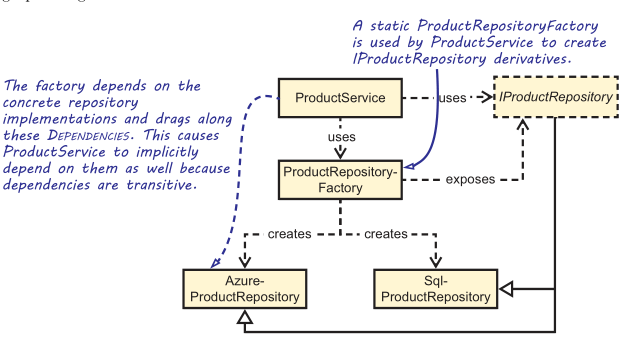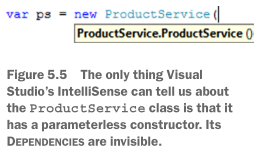反模式 DI anti-patterns
反模式 DI anti-patterns
《Dependency Injecttion Prinsciples,Practices, and Patterns》—— StevenVan Deursen and Mark Seemann
一、一、反模式 DI anti-patterns
1. 控制狂 Control freak
在程序设计中,"Control freak"(控制狂)通常指的是一种反模式,即过度控制和过度管理代码的设计和执行流程。这种情况下,程序员试图通过过度的控制和指令来达到对代码的绝对控制,而忽视了灵活性、可扩展性和可维护性。
控制狂在程序设计中可能表现为以下行为:
-
过度复杂的控制逻辑:设计过于复杂的控制逻辑,使得代码难以理解和维护。
-
过度使用全局状态:滥用全局变量或全局状态,使得代码之间的依赖关系变得混乱和难以追踪。
-
过度依赖条件语句:过多地使用条件语句(如if-else语句),导致代码逻辑分散、冗长和难以扩展。
-
过度使用硬编码:将具体数值、路径或配置直接硬编码到代码中,而不是使用配置文件或参数来实现灵活性。
这些行为会导致代码的可读性、可维护性和可扩展性下降,增加了代码的复杂性和脆弱性。相反,良好的程序设计应该追求简洁、模块化和松耦合的原则,以实现可维护、可扩展和易于理解的代码。
1-1. 示例:
- ...
- private readonly IProductRepository _productRepository;
- public ProductService()
- {
- //反模式范例,直接new一个SqlProductRepository,导致紧耦合
- _productRepository = new SqlProductRepository();
- }
- ...
1-2. 工厂模式下的反模式
实体工厂可以解决一些复杂物件建立逻辑封装在工厂中,可以避免写重复的代码。 但是在DI架构下,工厂模式没有带来益处。
- public class ProductRepositoryFactory
- {
- public static IProductRepository CreateProductRepository()
- {
- //工厂模式反模式范例,程序变复杂,只是控制狂换了个位置
- return new SqlProductRepository();
- }
- }
即便将上述代码改为读取外部配置的静态工厂,仍然是对问题换了个地方。ProductServiece依赖ProductRepositoryFactory,ProductRepositoryFactory又依赖于SqlProductRepository和AzureProductRepository,因此依赖传递导致ProductServiece对后两者的依赖。
- public static IProductRepository Create()
- {
- IConfigurationRoot configuration = new ConfigurationBuilder()
- .SetBasePath(Directory.GetCurrentDirectory())
- .AddJsonFile("appsettings.json")
- .Build();
- string repositoryType = configuration["productRepository"];
- switch (repositoryType)
- {
- case "sql": return new SqlProductRepository();
- case "azure": return AzureProductRepository();
- default: throw new InvalidOperationException("...");
- }
- }

1-3. 构造重载时的控制狂
下面案例中无参构造将SqlProductRepository作为外部预设,造成业务层对SQL数据层的依赖耦合
- private readonly IProductRepository repository;
- public ProductService()
- : this(new SqlProductRepository())
- {
- }
- public ProductService(IProductRepository repository)
- {
- if (repository == null)
- throw new ArgumentNullException("repository");
-
- this.repository = repository;
- }
2. 服务定位
服务定位是指在组合根之外的位置,一步特定的一群不稳定依赖对象,作为依赖需求组件提供给应用程序。
在程序设计中,
组合根”是指应用程序的起始点,负责组合(compose)整个应用程序的各个部分(如依赖注入容器、对象实例化、配置设置等)。Composition root通常位于应用程序的最顶层,是整个应用程序的组装中心。
具体来说,“组合根”负责以下几个主要任务:
- 实例化和配置应用程序中的各种对象和组件。
- 注册依赖关系,进行依赖注入(Dependency Injection)。
- 加载配置设置,设置应用程序的参数和行为。
- 协调应用程序中各个部分之间的交互和依赖关系。
通过将这些逻辑集中在一个地方,即“composition root”,可以实现应用程序的解耦和灵活性,使得应用程序的各个部分可以更容易地被替换、修改或扩展。这种设计模式有助于提高代码的可维护性和可测试性。
2-1. 示例:
- ...
- public class ProductService : IProductService
- {
- private readonly IProductRepository repository;
- //无参构造函数,让人看不清楚依赖关系
- public ProductService()
- {
- //通过服务定位组件Locator来获取实例
- this.repository = Locator.GetService<IProductRepository>();
- }
- public IEnumerable<DiscountedProduct> GetFeaturedProducts() { ... }
- }
- ...
- //简单服务定位的实现
- public static class Locator
- {
- private static Dictionary<Type, object> services =
- new Dictionary<Type, object>();
- //注册实例
- public static void Register<T>(T service)
- {
- services[typeof(T)] = service;
- }
- //获取实例
- public static T GetService<T>()
- {
- return (T)services[typeof(T)];
- }
- public static void Reset()
- {
- services.Clear();
- }
- }
- ...
- //以服务定位来进行单元测试
- [Fact]
- public void GetFeaturedProductsWillReturnInstance()
- {
- // Arrange
- var stub = ProductRepositoryStub();
- Locator.Reset();
- Locator.Register<IProductRepository>(stub);
- var sut = new ProductService();
- // Act
- var result = sut.GetFeaturedProducts();
- // Assert
- Assert.NotNull(result);
- }
2-2. 对服务定位反模式的反思
2-2-1. 服务定位的优点:
- 可以通过更改注册来支持延迟绑定。
- 可以并行开发代码,因为您是对接口进行编程,可以随意替换模块。
- 可以很好地分离关注点,因此没有什么能阻止您编写可维护的代码,但这样做会变得更加困难。
- 可以用TestDoubles来替换依赖项,从而确保了可测试性。
在程序开发中,Test Doubles是一种用于测试的替代品或模拟对象。它们被用来替代真实的依赖项或组件,以便在测试过程中隔离被测代码的行为。Test Doubles有多种类型,包括:
- Dummy Objects(哑对象):它们只是占位符,没有实际的实现,仅用于满足方法签名或参数要求。
- Fake Objects(伪对象):它们是真实的实现,但是在测试环境中使用简化的版本。例如,使用内存数据库替代真实的数据库。
- Stub Objects(存根对象):它们提供了预定义的响应,以便在测试中模拟特定的行为。例如,返回固定的数据或执行预定的操作。
- Spy Objects(间谍对象):它们类似于存根对象,但还会记录被调用的方法和参数,以便在测试中进行断言和验证。
- Mock Objects(模拟对象):它们是预先配置的对象,具有预期的行为和交互。通过使用断言来验证它们与被测代码之间的交互是否符合预期。
使用Test Doubles可以帮助在测试过程中隔离和控制依赖项,使测试更加可靠、可重复和可维护。这些替代品可以根据测试需要进行创建和配置,以模拟各种场景和条件。
2-2-2. 服务定位的坏处:
-
和服务定位器绑定的一些类别可能成为冗余
-
这个类使它的依赖性变得不明显

注意
在组合根区域使用DI容器,并不算服务定位反模式,它是一个基础框架组件。
3. 环境上下文
ambient context即环境上下文。在软件开发中,ambient context 是指一种模式,用于在应用程序中共享环境相关的信息或配置,而无需显式传递这些信息给每个组件或方法。这种模式通常通过线程本地存储(Thread Local Storage)或者类似的机制实现。一般在组合根之外的地方,透过一个全局存取的static修饰子类别成员。
通过 ambient context 模式,可以在整个应用程序中访问共享的环境信息,比如当前用户身份、语言设置、主题样式等,而无需在每个方法或组件中显式地传递这些信息。这种模式的优点在于可以简化代码,提高可维护性,并且避免了在每个组件中传递相同的上下文信息的重复工作。
需要注意的是,虽然 ambient context 可以简化代码,但过度使用它可能会导致代码难以理解和调试,因为它引入了隐式的依赖关系。因此,在使用 ambient context 模式时需要权衡利弊,并遵循良好的设计原则。
3-1. 示例
- public string GetWelcomeMessage()
- {
- ITimeProvider provider = TimeProvider.Current;
- DateTime now = provider.Now;
- string partOfDay = now.Hour < 6 ? "night" : "day";
- return string.Format("Good {0}.", partOfDay);
- }
3-2. 示例-查询时间用的环境上下文
- //查询当前系统时间的管道
- public interface ITimeProvider
- {
- DateTime Now { get; }
- }
- ...
- 静态类提供全局范围可读取实例
- public static class TimeProvider
- {
- //内建预设初始化
- private static ITimeProvider current =
- new DefaultTimeProvider();
- //全局范围类可对ITimeProvider不稳定依赖进行读取,设置的静态属性成员
- public static ITimeProvider Current
- {
- get { return current; }
- set { current = value; }
- }
- //预设
- private class DefaultTimeProvider : ITimeProvider
- {
- public DateTime Now { get { return DateTime.Now; } }
- }
- }
以环境物件反模式进行单元测试
- [Fact]
- public void SaysGoodDayDuringDayTime()
- {
- // Arrange
- DateTime dayTime = DateTime.Parse("20190101 6:00");
- var stub = new TimeProviderStub { Now = dayTime };
- //将原本预设替换为测试用替身
- TimeProvider.Current = stub;
- //WelcomeMessageGenerator构造API未揭露其需要ITimeProvier这层关系
- var sut = new WelcomeMessageGenerator();
- // Act
- string actualMessage = sut.GetWelcomeMessage(); //TimeProvider.Current与GetWelcomeMessage时序耦合
- // Assert
- Assert.Equal(expected: "Good day.", actual: actualMessage);
- }
3-3. 对环境上下文反模式反思
3-3-1. 环境上下文弊端
- “依赖项”已被隐藏起来了。
- 测试变得更加困难。
- 很难根据其上下文来改变依赖关系。
- 在依赖的初始化和使用之间存在时间耦合。
3-3-2. 将环境上下文重回DI正途
- 将这些环境上下文的调用集中到一处,这个订房的绝佳选择就是调用构造器的时候。
- 建立一个private readonly私有只读成员,用于存放透过环境上下文索取的依赖对象,之后类别中的所有需要这份以来的程序,都直接引用这个新的私有成员。
改进后的程序:
- public class WelcomeMessageGenerator
- {
- private readonly ITimeProvider timeProvider;
- public WelcomeMessageGenerator(ITimeProvider timeProvider)
- {
- if (timeProvider == null)
- throw new ArgumentNullException("timeProvider");
- this.timeProvider = timeProvider;
- }
- public string GetWelcomeMessage()
- {
- DateTime now = this.timeProvider.Now;
- ...
- }
- }
4. 限制性构造
限制性构造指某个抽象接口在实例化时,强制需要这些实体类别中有个同样识别定义的构造器,一遍延迟绑定。
4-1. 示例
强制对构造函数执行精确的签名
- public class SqlProductRepository : IProductRepository
- {
- public SqlProductRepository(string connectionStr)
- {
- }
- }
- public class AzureProductRepository : IProductRepository
- {
- public AzureProductRepository(string connectionStr)
- {
- }
- }
4-2. 示例-ProductRepository的延迟绑定
- string connectionString = this.Configuration
- .GetConnectionString("CommerceConnectionString");
- var settings =
- this.Configuration.GetSection("AppSettings");
-
- string productRepositoryTypeName =
- settings.GetValue<string>("ProductRepositoryType");
- var productRepositoryType =
- Type.GetType(
- typeName: productRepositoryTypeName,
- throwOnError: true);
- var constructorArguments =
- new object[] { connectionString };
- IProductRepository repository =
- (IProductRepository)Activator.CreateInstance(
- productRepositoryType, constructorArguments);
-
- ...
- {
- "ConnectionStrings": {
- "CommerceConnectionString":
- "Server=.;Database=MaryCommerce;Trusted_Connection=True;"
- },
- "AppSettings": {
- "ProductRepositoryType": "SqlProductRepository, Commerce.SqlDataAccess"
- },
- }
实际上,这没有意义,因为这表示了对依赖项的构造函数的意外约束。在这种情况下,您有一个隐式的要求,即IProductRepository的任何实现都应该有一个以单个字符串作为输入的构造函数,这就使IProductRepository实例化时受到额外的限制。
4-3. 限制性构造反模式的反思
虽然类似上面代码中这种限制最普遍,但在灵活性方面的成本是巨大的。无论您如何约束对象构造,您都会失去灵活性。
当您有多个类需要相同的依赖关系时,您可能希望在所有这些类之间共享一个实例。只有当您可以从外部注入该实例时,这才有可能实现。尽管您可以在每个类中编写代码,以从配置文件中读取类型信息并使用Activator.CreateInstance。 CreateInstance来创建正确的实例类型,它确实需要以这种方式共享单个实例。相反,同一类的多个实例会占用更多的内存。
4-4. 将限制器重回正途
借助抽象工厂模式,来产生抽象接口的实例,然后通过抽象接口的类别来配合某个构造器识别定义。

- public class SqlProductRepository : IProductRepository
- {
- private readonly IUserContext userContext;
- private readonly CommerceContext dbContext;
- public SqlProductRepository(
- IUserContext userContext, CommerceContext dbContext)
- {
- if (userContext == null)
- throw new ArgumentNullException("userContext");
- if (dbContext == null)
- throw new ArgumentNullException("dbContext");
- this.userContext = userContext;
- this.dbContext = dbContext;
- }
- }
SqlProductRepository 实现了IproductRespository接口,并且没有对IUserContext对象产生依赖。
 负面案例
负面案例
- public class SqlProductRepositoryFactory
- : IProductRepositoryFactory
- {
- private readonly string connectionString;
-
- //传入Mircorsoft的IConfigurationRoot让后读取需要的设定值。玩意要是设定值不存在,会在构建时抛出异常
- public SqlProductRepositoryFactory(
- IConfigurationRoot configuration)
- {
- this.connectionString =
- configuration.GetConnectionString(
- "CommerceConnectionString");
- }
- public IProductRepository Create()
- {
- //使用位于不同程序集中的依赖项创建一个新的IProductRepositoryFactory
- return new SqlProductRepository(
- new AspNetUserContextAdapter(),
- new CommerceContext(this.connectionString));
- }
- }
作者:世纪末的魔术师
出处:https://www.cnblogs.com/Firepad-magic/
Unity最受欢迎插件推荐:点击查看
本文版权归作者和博客园共有,欢迎转载,但未经作者同意必须保留此段声明,且在文章页面明显位置给出原文连接,否则保留追究法律责任的权利。






【推荐】国内首个AI IDE,深度理解中文开发场景,立即下载体验Trae
【推荐】编程新体验,更懂你的AI,立即体验豆包MarsCode编程助手
【推荐】抖音旗下AI助手豆包,你的智能百科全书,全免费不限次数
【推荐】轻量又高性能的 SSH 工具 IShell:AI 加持,快人一步
· winform 绘制太阳,地球,月球 运作规律
· AI与.NET技术实操系列(五):向量存储与相似性搜索在 .NET 中的实现
· 超详细:普通电脑也行Windows部署deepseek R1训练数据并当服务器共享给他人
· 【硬核科普】Trae如何「偷看」你的代码?零基础破解AI编程运行原理
· 上周热点回顾(3.3-3.9)